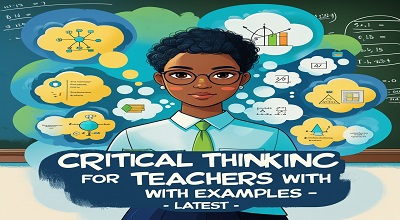Critical Thinking for Teachers
Critical Thinking for Teachers: Critical thinking is the ability to analyze, evaluate, and synthesize information objectively to make reasoned judgments. For teachers, fostering critical thinking is essential to help students navigate complex problems, make informed decisions, and develop independent thought processes.
In today’s fast-evolving educational landscape, teachers must not only practice critical thinking themselves but also cultivate it in their students. This blog explores the importance of critical thinking for educators, practical examples, and the latest trends in teaching this vital skill.
Why Is Critical Thinking Important for Teachers?
Teachers play a pivotal role in shaping students’ intellectual and problem-solving abilities. Here’s why critical thinking is crucial for educators:
A. Enhances Decision-Making
Teachers constantly make decisions—lesson planning, classroom management, and student assessments require logical reasoning.
B. Promotes Student Engagement
Critical thinking encourages active learning, where students question, debate, and explore concepts deeply.
C. Prepares Students for the Future
In a world dominated by AI and misinformation, critical thinking helps students discern facts from falsehoods.
D. Encourages Reflective Teaching
Teachers who think critically reflect on their teaching methods and adapt to improve student outcomes.
Key Components of Critical Thinking
Critical thinking involves several interconnected skills:
| Component | Description |
|---|---|
| Analysis | Breaking down information into smaller parts for better understanding. |
| Evaluation | Assessing the credibility and relevance of information. |
| Inference | Drawing conclusions based on evidence. |
| Problem-Solving | Applying logical steps to resolve issues. |
| Creativity | Thinking outside the box to generate innovative solutions. |
| Reflection | Reviewing one’s thought processes for improvement. |
How Teachers Can Develop Critical Thinking Skills?
Teachers must continuously refine their critical thinking abilities. Here’s how:
A. Engage in Professional Development
- Attend workshops on cognitive pedagogy.
- Read research on metacognition and reasoning.
B. Practice Reflective Journaling
- Write daily reflections on teaching experiences.
- Identify biases and areas for improvement.
C. Collaborate with Peers
- Discuss teaching strategies with colleagues.
- Participate in critical thinking exercises together.
D. Use Real-World Problem-Solving
- Apply classroom theories to practical scenarios.
- Encourage open-ended discussions.
Examples of Critical Thinking in the Classroom
Here are practical examples of how teachers can integrate critical thinking:
1: Socratic Questioning
- Scenario: A history teacher asks, “Why did World War II start?”
- Critical Thinking Approach: Students analyze political, economic, and social factors rather than memorizing dates.
2: Debate on Ethical Dilemmas
- Scenario: A science teacher presents a debate on genetic engineering.
- Critical Thinking Approach: Students evaluate pros and cons, supporting arguments with evidence.
3: Case-Based Learning
- Scenario: A math teacher gives a real-world budgeting problem.
- Critical Thinking Approach: Students apply mathematical concepts to create feasible solutions.
Strategies to Foster Critical Thinking in Students
Teachers can use these methods to nurture critical thinking in learners:
A. Encourage Questioning
- Use “Why?” and “How?” prompts.
- Reward curiosity.
B. Implement Problem-Based Learning (PBL)
- Present real-world problems for group solutions.
- Guide students through the reasoning process.
C. Use Scaffolding Techniques
- Break complex tasks into manageable steps.
- Provide hints rather than direct answers.
D. Incorporate Technology
- Use AI tools for fact-checking exercises.
- Engage in online collaborative discussions.
Challenges in Teaching Critical Thinking
Despite its importance, teaching critical thinking comes with hurdles:
- Student Resistance: Some prefer rote learning.
- Time Constraints: Developing reasoning skills takes time.
- Assessment Difficulties: Standardized tests may not measure critical thinking effectively.
Latest Trends in Critical Thinking Education
Recent developments include:
- AI-Assisted Critical Thinking: Tools like ChatGPT help simulate debates.
- Gamification: Using puzzles and strategy games to enhance reasoning.
- Global Collaboration Projects: Students solve cross-cultural problems together.
Conclusion
Critical thinking is indispensable for teachers and students alike. By integrating analytical reasoning, reflective practices, and innovative teaching strategies, educators can prepare learners for a complex world. Stay updated with the latest trends to keep your teaching methods effective and engaging.
More Here: PUBG Desi ESP APK
